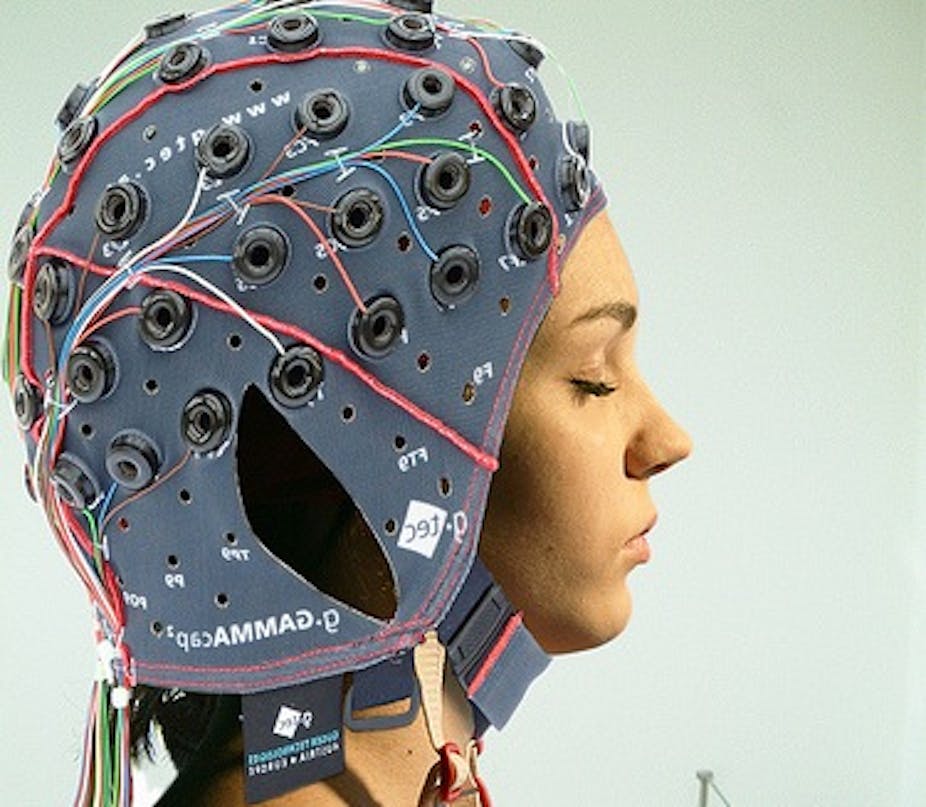Human brains evolved over the last four million years in response to the interaction between environmental challenges and behaviours that enabled us to overcome these challenges. But the future of the brain may be more directly in human hands.
Our ancestors became more successful at ensuring their survival with greater behavioural complexity over time. So their bodies grew in size because of more efficient ways of obtaining foods. And the advantages of greater body size and strength provided security from predator attacks.
As our bodies were growing taller – from about 1.2 metres 3.5 million years ago to about 1.7 metres at the end of the Ice Age some 10,000 years ago, brain expansion followed. This is not surprising because bigger bodies need more nerve cells to control them. But this part may come as a surprise – during the last few thousand years, especially from the time the oldest civilisations arose (about 5,000 years ago) our brains became smaller (yes, smaller!) by about 10%.
This process sped up in the last 2,000 years (see the graph below). If the size of human brain was related to mental ability, this would contradict the increasing sophistication of human knowledge during our recent history.

Recent research suggests that the gene ASPM, which regulates brain growth, is still directing brain evolution. But since the brain is neuro-plastic (changed by learning), in the future it may be enhanced using various biotechnologies. These technologies may include brain-machine interfaces, nootropic substances (drugs for enhancing memory and cognition) and human-non-human gene splicing.
Brain-machine interfaces
Knowledge of how nerve cells communicate with each other to process information in our brains (connecting electric signals by chemicals) can now be used to improve brain function. Electrical interfaces between machines and nerve cells can allow direct input of electronically-processed information into our nervous system. Artificial cochlear implants “talk” to our auditory cortex and the first electronic chips were connected to human visual tracts this year, allowing blind patients to see.
In the future, brain-machine interfaces may offer further improved sensory and cognitive abilities. Futurist thinkers, such as Ray Kurzweil, believe that in the near future neural implants will be so widespread that humans will need them in order to live normally in a high-tech society.
It could even be conceivable that future humans may order “designer label” neural implants that work in tandem with novel virtual reality technologies to produce a kaleidoscope of experiences. Such technologies may provide us with deeper insights into human nature, spirituality and the universe. Just imagine a neural implant working with virtual reality to create fantastical worlds.

Future technologies may also be capable of enhancing alternate forms of communication, such as telepathy. The American Defense Advanced Research Projects Agency (DARPA) is currently in the process of creating a “telepathic helmet” that may offer a technology-based form of telepathic communication between soldiers. If the helmet proves to be successful, it may open the way for the creation of similar telepathic devices that could be used by civilians. These would be veritable “mind machines”!
New nootropics
We also face the prospect of cosmetic neurology – the use of nootropics (drugs that enhance memory or cognitive functions). Mind-enhancing agents such dextro-amphetamine are sometimes used by university students as a study aid, while modafinil is said to improve memory and attention.
Some people in the highly competitive business world are using various nootropics to give them a “mental edge”. While this may be an increasing trend, future-designed nanotechnology-based drugs will offer greater precision and efficiency in stimulating the brain.
Indeed, as precise knowledge of brain functions increases, we may be able to create better nootropics. Such drugs may be able to construct brain molecules or enhance areas of the brain, helping individuals develop new talents and abilities.
The promise of gene technology
Gene therapy in the form of splicing human and animal DNA may provide certain cognitive advantages. According to Oxford scholar Julian Savulescu, splicing human and animal DNA may not only enhance human cognition and perception but will have wider health and social benefits.

We could improve memory function, for instance, by transferring the elephant gene responsible for long-term memory to humans. Similarly, human night vision could be enhanced by splicing owl gene. Such novel splicing could have a number of social implications, from reducing night-time road accidents to assisting rescue teams.
The 21st century and beyond promises an array of novel methods for enhancing human cognition. Perhaps such improvements will enable future humans to find long-lasting solutions to global problems, as well as to go to the stars. Such promises, however, can be fulfilled only if we all value learning and intellectual development over short-term commercial gains.

